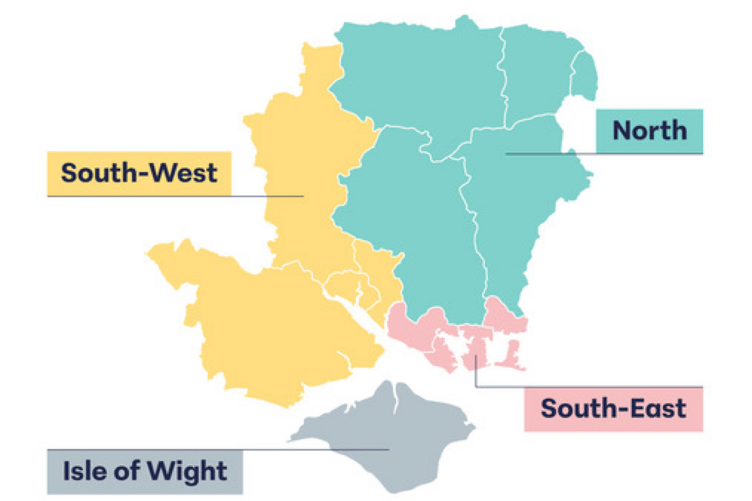East Hampshire District Council (EHDC) will next week consider a major proposal to simplify local government across Hampshire and the Solent, replacing the current 15 councils with four new unitary authorities.
The proposed change follows a central government requirement for all ‘two-tier’ council areas to transition to single-tier systems.
This means that district, borough, and county councils would no longer exist, and instead unitary councils would deliver all services, including social care, education, waste collections, and planning.
EHDC has worked jointly with Hampshire County Council to develop a preferred model that recommends creating three new unitary councils on the Hampshire and Solent mainland, while the Isle of Wight would remain as a standalone unitary authority.
Under this model, the North unitary council would cover East Hampshire, Hart, Rushmoor, Basingstoke and Deane, and Winchester.
The South-West council would include Eastleigh, New Forest, Southampton, and Test Valley, while the South-East council would consist of Fareham, Gosport, Havant, and Portsmouth.
The recommended option is the result of a thorough assessment using robust methodology, extensive research, and financial analysis, as well as feedback from residents, public service partners, and local government experts. Councillors are being advised that this model offers the best balance of simplicity, stability, and savings.
Financial analysis indicates it would save nearly £50 million a year after the initial payback period and would have the lowest setup costs. The proposal seeks to build on the strengths of existing councils and avoid unnecessary disruption to services such as waste collection and planning, while ensuring vital services like social care and education continue without interruption.
Two other options were considered but ruled out following a detailed appraisal. The three-council model would have created two large mainland councils alongside the Isle of Wight.
While this could have saved more money on paper, it was assessed as too risky, as it would involve breaking up existing services and merging large areas, creating significant disruption, particularly for vulnerable residents who rely on services such as adult social care and children’s services.
There were also concerns it could dilute local identity and make it harder for councils to respond to local needs.
The five-council model would have created four mainland councils and the Isle of Wight, but one of the councils would need to be built entirely from scratch, taking on major responsibilities for education, roads, waste disposal, and social care for the most vulnerable adults and children.
This was identified as the most expensive and risky option, with no existing staff, systems, or leadership in place. It would take more than a decade to pay for itself and could lead to higher council tax bills or cuts to services such as libraries and recycling centres.
Both the three-council and five-council models were found to risk breaking up services, creating less joined-up thinking, and resulting in greater inequality between areas, meaning some residents could receive better services than others depending on where they live.
The preferred four-council proposal is seen as offering a smoother and more secure transition, delivering better value for money and ensuring services remain accessible for residents.
Cllr Richard Millard, leader of EHDC, said: “This is a significant moment for the future of local government in Hampshire and the Solent. With increasing pressures on public services, we are looking at how we can simplify the system and deliver better outcomes for our residents.
“What sets this proposal apart is the robust, evidence-based approach taken to develop it. The use of data and a clear methodology has given us a strong foundation for a serious conversation about how local government should evolve.
“This is now a decision for councillors. It’s vital that all members consider the long-term benefits for residents, communities, and the sustainability of local services when weighing up the options.
“This proposal has been developed with a spirit of collaboration and reflects a shared commitment to improving public services through innovation. As this progresses, continued partnership will be key to delivering the best outcomes for our residents, whichever model is agreed.”
Cllr Nick Adams-King, leader of Hampshire County Council, said: “The Government has made it clear that all two-tier council areas like ours need to move to a single-tier system by 2028. That means big changes to how local services are run and it’s important we get it right.
“Working with our colleagues at East Hampshire District Council, we’re determined to secure the best results for residents in this transition, so our aim is for new councils to be strong, reliable, and easy to understand - that put local people first and make life simpler.
“They would run all local services in their area and build on what’s already working well - avoiding unnecessary disruption, and protecting key services like social care, education, highways, planning and waste. Our vision for local government would also make sure local communities keep their identity and have a strong say in local decisions.
“We’ve looked carefully at all the options. Some would save more money on paper, but they come with bigger risks – like breaking up services, creating confusion, or putting too much pressure on councils already facing financial challenges. Others would cost significantly more and take longer to deliver any benefit.
“We will be carefully considering this four-council model which aims to strike the right balance. Councillors will be looking closely to determine that it presents the most practical and affordable solution, puts residents first and offers the best chance of making the transition smoothly – so everyone continues to get the services they rely on, and councils can focus on delivering better outcomes for local people.”
The preferred option will be considered by EHDC’s Full Council on Thursday, July 17,, and by EHDC’s Cabinet the following day.
If councillors choose to move forward, a public engagement period will run from July 21 to August 17 to gather views from residents and stakeholders.
Feedback will help shape the final proposal, which will be considered in September before being submitted to the Government by September 26.





Comments
This article has no comments yet. Be the first to leave a comment.